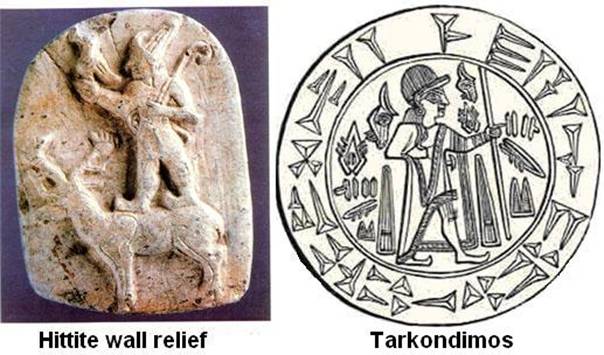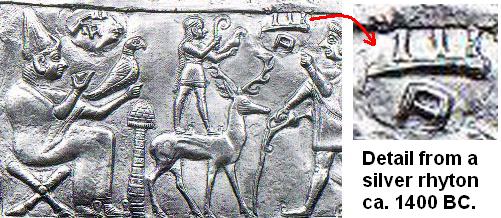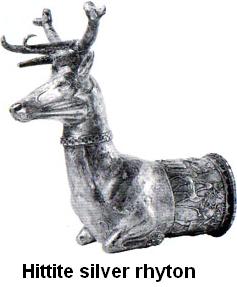|
During
the second millennium B.C.
Anatolia has
been the focal point of cultural transformation. During this
period several city states were founded and different writing
systems were used simultaneously. In Alacahöyük and in the
central regions of Anatolia the Hittites raised several cities
(see map at Chapter 12, The Anatolian expansion). Many
statues, wall relief, amulets, written tablets and seals have
been found dated from this period. They are presently
displayed in many different museums of the world. Hittite
language is claimed to belong to the Indo-European language
group. This is because Bedrich F. Hrozny, a Czech linguist who
lived from 1879 to 1952, found two words in Hittite;
wadar
meaning “water” and ezzan meaning “to eat”, similar to
German wasser and
essen, that the language has
been classified as the first Indo-European language. But in
fact Hittite is an intermediate language in transition. We
find several forms and features from both Altaic as well as
Germanic languages. This characteristic will be explained in
future chapters.
The wall
relief below left is a synthetic message, comparable to a
written text when properly interpreted. The pointed hat with
curved horns and the trousers worn by the person on top of an
elk are typical Scythian symbols mentioned by Herodotus (see
Chapter 4, The Asiatic Scythians). He holds an eagle on
his gloved right hand. Hunting with eagles and hawks is a
tradition that is still being used by Asiatic people. He holds
a curved staff in his left hand (a kalmush or lituus), an
instrument used by shepherd for catching runaway sheep. The
elk is the symbol representing the leader of Asiatic people.
This symbolism has been mentioned and explained in detail in
the previous chapters. His position on the elk is a sign of
superiority and leadership. Therefore, the message embedded on
this stele is “I am the shepherd and the hunter leading the
people”.

Above right we
see a seal whose original size is about half an orange.
Archibald. H. Sayce (1846-1933) who worked on the decipherment
of Hittite Hieroglyphs read these inscriptions as: “Tar-rik-tim-me
Sar-mat Er-me-e”, which he interpreted as
Tarkondimos, King of the
land of Erme”
(1). This is how the seal became known as the Tarkondimos
seal.
I am of the
opinion that the inscription on the seal can be differently
interpreted.
Herodotus of
Halicarnassus
(484 BC – 425 BC) was the first historian who wrote a
comprehensive account of antique Anatolian and surrounding
cultures. He said that the Scythians, the Amazons and the
Sarmatians spoke a common language
(2). The Sarmatians
occupied the regions above the Black Sea and in my opinion the
second word of the seal “Sar-mat” stand for
Sarmat,
the people mentioned by Heredotus.
The first word
Tar-rik-tim-me can be read as: “Tur-ruk-tum ma“, which
can be transliterated as “I was a Tur from the north but”.
The first root word is no other than the Asiatic Tur
and the second root word “ruk” means “from the north” (see
Chapter 4). “Ruk” can be read as “uruk”, which means “the
north settlement”. There is a Sumerian city called Uruk which
is situated at the north of Ur. The suffix “-tum” means “I
was” and “ma” stands for “but” (ama being “but”) in
Turkish.
The last word
on the seal “Er-me-e” is a transposed form of “Er-i-em”, which
means “I am the man, the soldier”. Therefore, the three
words can now be understood as: “I was a Tur from the north
but I belong to the Sarmat”. We see that this
interpretation does not lead to Tarkondemos but rather to a
meaningful sentence. But even if my interpretation is wrong,
Tarkan, Tur-Khan or
Tarkon is to be found in the
first part of Tarkon-dimos (see Chapter 5, Climatic Changes).

A further clue
for the Asiatic origin of the Hittite can be found in the
picture above (3). This picture is part of a Hittite silver
rython (a drinking vessel used only on special occasions). The
rhyton shown below (dated from 14th century BC) is
18cm high and is exhibited at the Metropolitan Museum of Art,
NY. In the detail above we see a seated god holding a hawk on
his left hand and a small cup on his right hand. The small cup
is extended as a sign of celebration. We can assume that the
seated figure is a god since the sitting position has always
been considered as being superior to standing. The seated god
is behind the person standing on the stag who is the Hittite
king. The seated god looks in the same direction as the
Hittite king as a sign of support and ownership. The other
person pouring water to the feet of the stag is the visiting
king. He lifts his left hand as a sign of salutation and
goodwill. He is pouring water to the ground, which has always
been considered as a sign of wish for growth among Asiatic
cultures.
There are two
symbols between the head of the kings, which have been
enlarged on the right hand side of the above picture. The top
one can be interpreted as UTCH meaning “top, leader and
also the number three” (see Chapter 10,
Etruscan
inscriptions). The sign under the utch can be interpreted
as being a
Rho
(ρ) which is the archaic form of R. These two seals
(characters) are root words originating from the Asiatic
Proto-language. Together they can be interpreted as: “The
kings” or “the ones at the top”, where the second sign stands
for the plural suffix “-ar” in Etruscan and “-lar” in Turkish.
There is a similar R sign on the top left part of picture
above. The R sign stands under the name of the god. This may
be an indication for respect, since respectful people have
always been addressed in plural.

|